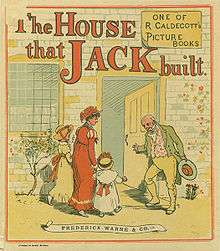Cumulative tale

In a cumulative tale, sometimes also called a chain tale, action or dialogue repeats and builds up in some way as the tale progresses. With only the sparest of plots, these tales often depend upon repetition and rhythm for their effect, and can require a skilled storyteller to negotiate their tongue-twisting repetitions in performance.[1] The climax is sometimes abrupt and sobering as in "The Gingerbread Man." The device often takes the form of a cumulative song or nursery rhyme. Many cumulative tales feature a series of animals or forces of nature each more powerful than the last.
History
Cumulative tales have a long pedigree. In an early Jewish Midrash, considered to date from the sixth century AD, Abraham is brought before King Nimrod, who commands him to worship fire.[2] Abraham replies that it would be more reasonable to worship water, which can quench fire and is therefore more powerful. When this premise is granted, he points out that the clouds, as sustainers of water, are more worthy of worship, and then that the wind that disperses them is more powerful still. Finally he confronts Nimrod with the observation that "man can stand up against the wind or shield himself behind the walls of his house" (Genesis Rabba xxxviii).
There is a similar tale, The Mouse Turned into a Maid, in the Panchatantra, in which the mouse-maid is successively introduced to the sun, the cloud, the wind and the mountain. She prefers each in turn as stronger than the last, but finally a mouse is found to be stronger than even the mountain, and so she marries the mouse. Stories of this type, such as the Japanese The Husband of the Rat's Daughter, are widely diffused.[3]
Classification
In the Aarne-Thompson classification system, types 2000-2100 are all cumulative tales, including:[4]
- Chains Based on Numbers, Objects, Animals, or Names 2000-2020
- How the rich man paid his servant 2010
- The house is burned down 2014
- The goat that would not go home 2015
- Fair Katrinelje and Pif-Paf-Poltrie 2019
- Chains Involving Death 2021-2024
- The cock and the hen 2021
- An Animal Mourns the Death of a Spouse 2022
- Chains Involving Eating 2025-2028
- The Fleeing Pancake 2025
- The fat cat 2027
- Chains Involving Other Events 2029-2075
- The Old Woman and Her Pig 2030[5]
- The Sky Is Falling 2033
- This Is the House That Jack Built 2035
- The Mouse Who Was to Marry the Sun 2031C (Japanese, Indian)
- Pulling up the turnip 2044
- Tales in which animals talk 2075
Other examples of cumulative tales
- "The Death of the Little Hen"[6]
- Why Mosquitoes Buzz in People's Ears
- The Fisherman and His Wife
- The Stonecutter
- Chad Gadya
- Green Eggs and Ham
- Drummer Hoff
- There Was an Old Lady Who Swallowed a Fly
- I Bought Me a Cat, featured in the 1950 Aaron Copland song set Old American Songs
- The Old Woman and the Pig
- The Train to Glasgow by Wilma Horsbrugh , later set to music by The Singing Kettle
- And The Green Grass Grew All Around
- Old MacDonald Had a Farm
- A Fly Went By
- Court of King Caractacus - song by Rolf Harris, later recorded by The Singing Kettle
Notes
- ↑ Ashliman, D.L. "Chain Tale". In Donald. Haase. The Greenwood encyclopedia of folktales and fairy tales. Greenwood Press. p. 176. ISBN 978-0-313-33441-2.
- ↑ See the Text of the Midrash Raba version. This is not itself a cumulative tale, though many cumulative tales seem to echo its theme.
- ↑ D. L. Ashliman, "The Mouse Who Was to Marry the Sun: fables of Aarne-Thompson type 2031C"
- ↑ D. L. Ashliman's page of story types
- ↑ The Old Woman and Her Pig, English Fairy Tales by Joseph Jacobs, Everyman's Library 1993 ISBN 978-1-85715-917-2 In his notes Jacobs gives the source of this tale as Halliwell’s Nursery Rhymes and Tales, 114, lists parallels and mentions that it is one "of the class of Accumulative stories, which are well represented in England."
- ↑ The first part of this tale is cumulative. Collected by the Brothers Grimm; given in Wikisource.
External links
- The Old Woman and Her Pig from "English Fairy Tales" by Joseph Jacobs
- A shared chain story from three non-contiguous groups in Papua New Guinea